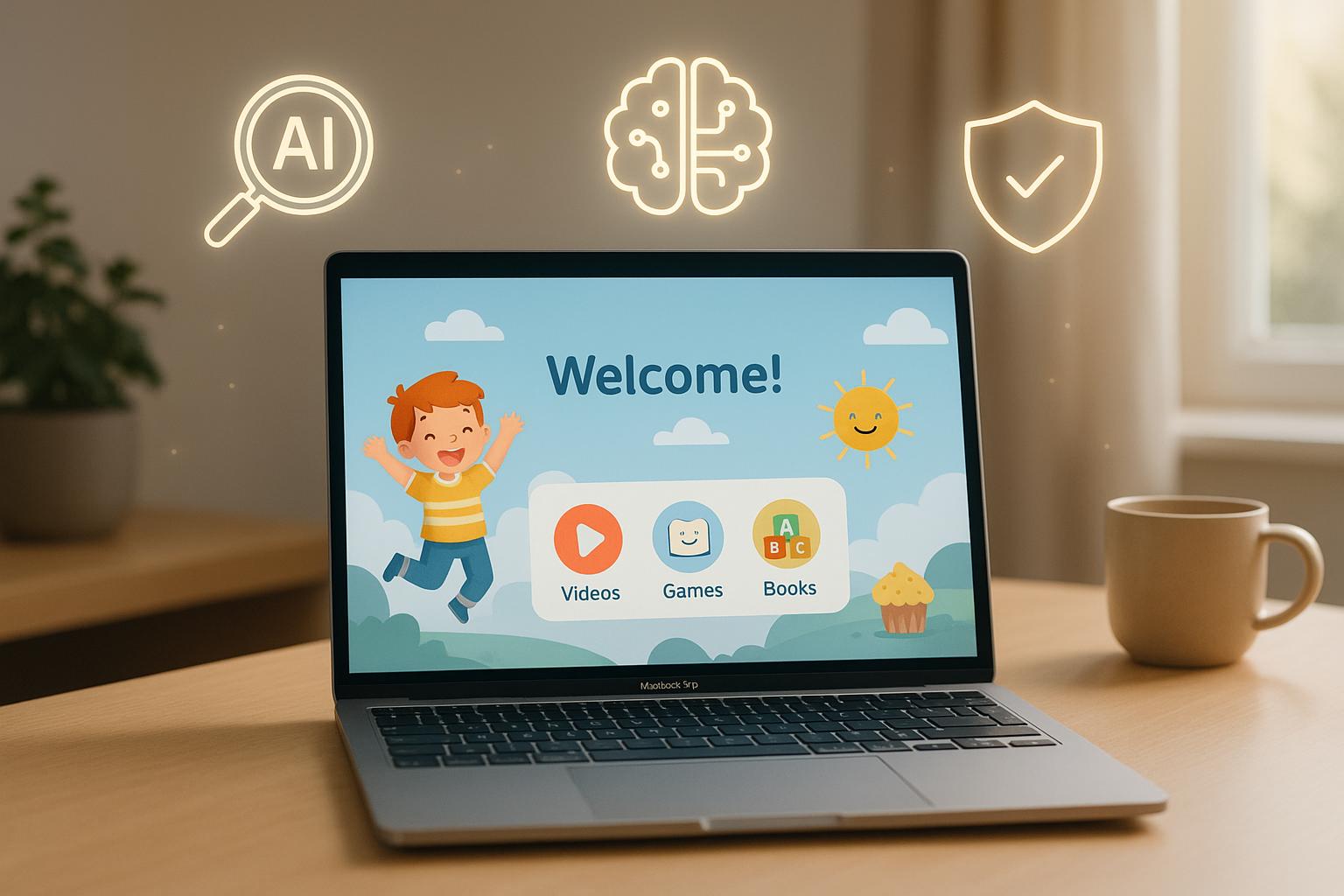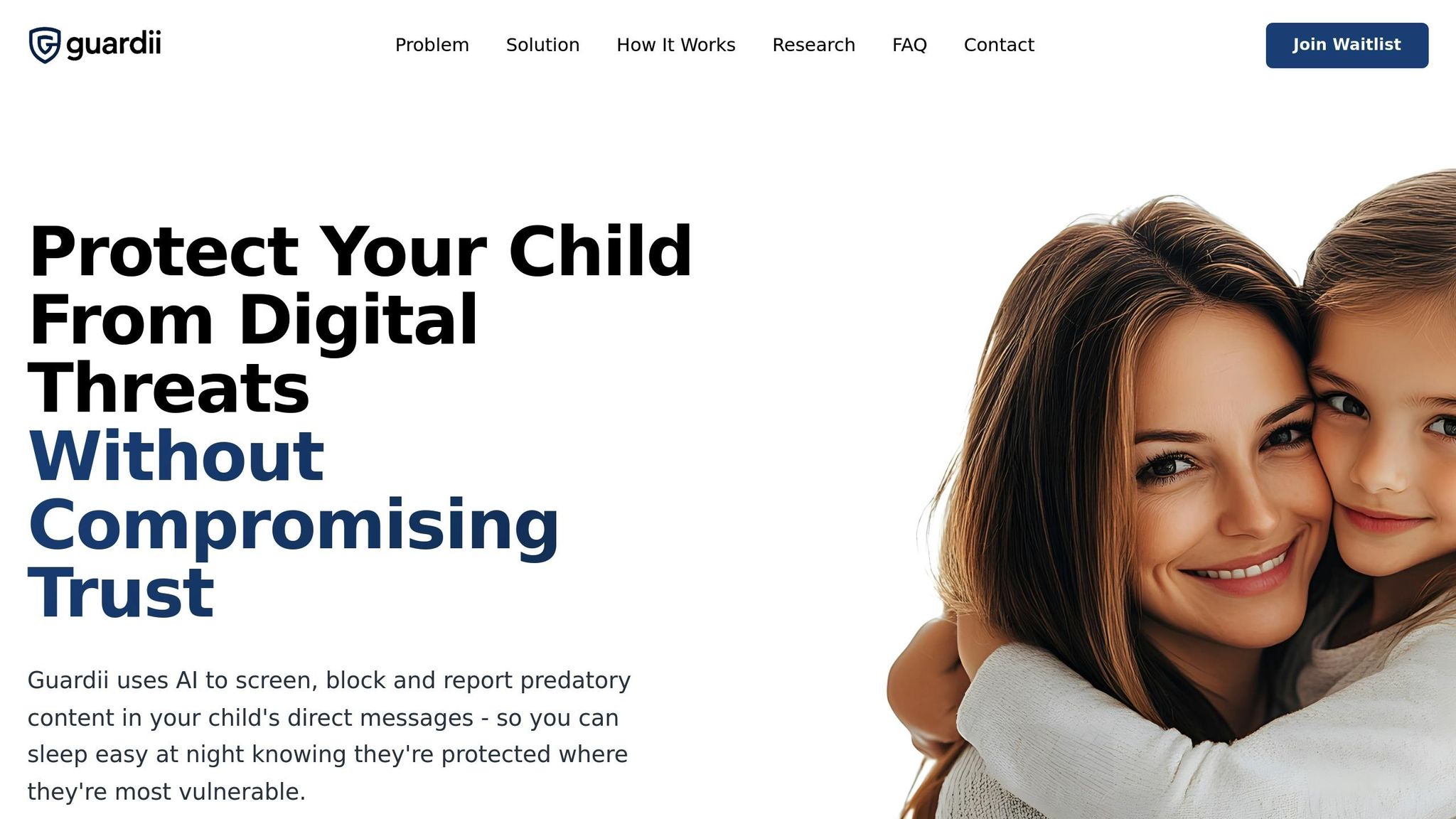
How AI Detects Age-Inappropriate Content
Artificial intelligence (AI) is transforming online child safety by identifying harmful content in real time. With tools like natural language processing (NLP), computer vision, and audio recognition, AI systems analyze text, images, videos, and audio to detect risks such as explicit material, violent imagery, or predatory behavior. These systems can evaluate context, ensuring protections are tailored to a child’s age and maturity level. Platforms like Guardii offer features including real-time monitoring, age-specific safeguards, and alerts for parents, all while respecting privacy. This makes AI a powerful tool in keeping children safe as they navigate the digital world.
AI-powered smartphone blocks explicit content | ABS-CBN News

What Is Age-Inappropriate Content
Age-inappropriate content refers to material designed for adults that can harm children by exposing them to concepts they are not yet ready to process emotionally or cognitively. What’s considered appropriate depends heavily on a child’s age, maturity level, and ability to think critically. Data sheds light on just how widespread this issue is.
For instance, 75% of parents worry about their children encountering such content, with 73% specifically concerned about exposure to adult material. Alarmingly, 45% of children aged 8 to 17 report coming across online content that made them feel uncomfortable or upset.
Types of Age-Inappropriate Content
This type of content comes in many forms, each carrying its own risks:
- Sexually explicit material: Around 50% of children aged 9 to 16 have seen sexual images online.
- Violent content: Exposure to violent material on social media has left 25% of teenagers feeling more fearful. In Australia, 57% of young people aged 12 to 17 have come across real-life violence online.
- Extremist and terrorist content: About 33% of Australian youth aged 12 to 17 have encountered media promoting terrorism.
Why Context Matters in Content Detection
AI’s ability to evaluate context is vital when determining whether content is appropriate for children. The same material can have vastly different effects depending on the child’s age and developmental stage. For example, a high school student might benefit from a medical diagram of human anatomy, while the same image could confuse or upset a seven-year-old. Similarly, a news story about war might help a teenager understand global events but could overwhelm a younger child.
Legal guidelines and platform ratings, such as PEGI for video games or film age classifications, offer general recommendations. However, these systems often lack the nuance to assess how specific content might affect an individual child.
The risk of exposure to harmful material grows when children use the internet unsupervised, access social media before meeting minimum age requirements, or engage with apps and games not suited to their developmental needs. A concerning gap also exists between children’s experiences and what parents perceive: while 21% of children report seeing violent content online, only 14% of parents are aware of it. This highlights the need for better monitoring tools to help parents stay informed about their children’s digital interactions.
Context also plays a role in how content impacts a child. A child who accidentally encounters disturbing material while alone might react much differently than one who sees similar content in a structured, educational environment. Timing, setting, and the presence of guidance can all influence how a child processes what they see.
AI Methods for Detecting Harmful Content
AI systems deploy sophisticated techniques to analyze various forms of content - text, images, videos, and audio - to identify material that could pose risks to children. These methods are designed to proactively filter out harmful content, helping to safeguard children’s mental and emotional well-being.
Natural Language Processing (NLP) for Text Content
Natural language processing (NLP) enables AI to interpret and analyze written text for signs of harmful behavior, inappropriate language, or predatory actions. Instead of focusing on isolated words, these systems examine the broader context and intent behind conversations. For instance, NLP models can identify grooming tactics, such as attempts to isolate children, requests for personal information, or efforts to move conversations to private platforms. They also detect harmful speech like bullying, threats, insults, and identity-based attacks by analyzing sentence structure, word usage, and how conversations progress.
By combining text analysis with additional data - such as user behavior patterns and the timing of interactions - AI systems can better identify suspicious activities. This layered approach makes it possible to catch harmful behavior that might otherwise go unnoticed. Beyond text, AI applies similar principles to visual content.
Computer Vision for Images and Videos
Computer vision technology enables AI to assess visual content for elements that may be inappropriate for children. By analyzing pixels, shapes, colors, and patterns, these systems can identify explicit sexual content, violent imagery, or other visuals unsuitable for young viewers.
AI models trained on diverse datasets are capable of recognizing both overt and subtle cues in images. They break visuals into components, evaluating details like skin exposure, body positioning, facial expressions, and the surrounding environment to determine whether the content meets age-appropriate standards. With real-time processing, these systems can analyze images and videos as they are shared, effectively curbing the spread of harmful visuals. In addition to text and visual data, AI also examines spoken content to ensure a comprehensive approach.
Audio Recognition for Spoken Content
Audio recognition systems analyze spoken language to detect harmful speech patterns, assess emotional tones, and monitor conversations. Using deep learning and advanced signal processing techniques, these systems evaluate both the content of speech and the way it is delivered.
Key audio features - such as tone, pitch, volume, and speech rate - are analyzed to assess emotional states and identify potentially harmful intent. Preprocessing steps, like noise reduction and voice activity detection (VAD), help isolate speech from background noise, ensuring accurate analysis.
These systems can operate in two modes: conversational mode focuses on one-on-one interactions, while observational mode monitors group discussions for concerning trends. When a potential threat is detected, the system can take immediate action, such as sending warnings to children or notifying parents and guardians. Combining audio analysis with speech-to-text transcripts further enhances the system’s ability to understand context, making it more effective at identifying subtle risks that might be overlooked when analyzing audio alone.
sbb-itb-47c24b3
Real-Time Monitoring and Age-Based Protection
Using advanced tools like natural language processing (NLP) and computer vision, AI has become a powerful ally in child safety. These systems don’t just detect harmful content - they act on it instantly while tailoring protections to suit a child’s age and maturity. Modern AI operates non-stop, analyzing online interactions as they happen and adjusting measures to meet the unique needs of each user.
Real-Time Threat Detection in Digital Interactions
AI-powered monitoring systems work tirelessly, scanning conversations, images, and audio content the moment they appear. This rapid analysis is critical because harmful interactions can escalate in seconds, especially on direct messaging platforms where predators often attempt to gain a child’s trust before escalating their behavior.
When a potential threat is identified, AI acts in milliseconds. It can flag, block, or send alerts as needed. This speed is crucial because children often make impulsive decisions online - whether it’s sharing personal details or responding to unfamiliar individuals. Real-time monitoring ensures harmful interactions are stopped before they spiral out of control.
For example, if a stranger starts asking for personal information or tries to move a conversation to a private channel, the AI system can step in immediately. It might block the messages or notify a parent or guardian, effectively halting the situation before it progresses.
Beyond immediate responses, AI also tracks historical interaction patterns. By analyzing multiple conversations, it can identify grooming behaviors that may not be obvious in a single exchange. This type of behavioral analysis helps to uncover subtle signs of manipulation, enabling a more comprehensive approach to safety.
In addition to this real-time vigilance, AI systems offer age-specific protections that adapt to a child’s developmental stage.
Age-Based Protection Settings
Children of different ages face different online risks, and AI systems are designed to adjust their safeguards accordingly. A 7-year-old, for instance, needs stricter content filtering than a 15-year-old, yet both require protections tailored to their vulnerabilities and digital experience.
AI creates dynamic protection profiles that evolve as children grow. These profiles don’t just rely on chronological age - they also consider factors like digital literacy, communication habits, and individual risk levels. For younger children, the system might block all unsolicited contact from strangers. For teenagers, it could focus on identifying manipulation tactics, cyberbullying, or harmful content.
Content sensitivity is another area where AI adapts based on age. What’s deemed inappropriate for a younger child might not be flagged for an older teen. AI maintains extensive databases of age-appropriate standards and adjusts its detection thresholds to match each user’s profile.
Behavioral analysis plays a key role here, too. By observing how children of various ages typically interact online, AI builds models of “normal” behavior for each group. If a young child suddenly starts using advanced language or discussing topics beyond their age level, the system can flag these as potential signs of manipulation or coaching by predators.
Parents also have the ability to customize these protections within age-appropriate ranges. This flexibility allows families to align safety settings with their values and their child’s maturity. Over time, the AI learns these preferences, refining its approach while maintaining essential safeguards.
Age-based protection isn’t just about blocking threats - it’s also about education. Younger children might receive simple warnings, like reminders not to talk to strangers. Older kids, on the other hand, might get more detailed explanations about online risks, such as manipulation tactics or the dangers of oversharing.
Guardii’s AI platform is a prime example of this approach. It continuously monitors direct messaging interactions while tailoring protections to each child’s needs, ensuring both real-time safety and age-appropriate guidance.
Guardii's AI-Based Child Safety Platform

Guardii uses advanced AI to keep children safe online, balancing protection with respect for privacy and encouraging healthy digital habits.
At its core, Guardii operates on the belief that safeguarding children doesn’t have to mean intruding on their privacy. Its AI is designed to distinguish everyday conversations from those that might signal potential risks, minimizing unnecessary alerts and notifying parents only when truly needed.
"We believe effective protection doesn't mean invading privacy. Guardii is designed to balance security with respect for your child's development and your parent-child relationship."
The platform’s context-aware system evaluates entire conversations, picking up on subtle language that could indicate grooming while ignoring harmless exchanges. This approach ensures a more accurate and reliable safety net for children.
Key Features of Guardii's AI Platform
Guardii builds on its advanced detection system with tools designed to simplify and enhance child safety:
- Smart Filtering Technology: This feature uses context to identify harmful content while keeping false positives to a minimum. It also blocks harmful messages in real time.
- Parent Dashboard: Offers a streamlined view of essential insights, avoiding unnecessary details about routine interactions.
- Age-Appropriate Protection: Automatically adjusts its sensitivity as kids grow, offering tailored protection that evolves with their digital maturity.
- Timely Alerts: Parents are notified only when there’s genuine cause for concern.
- Evidence Preservation: Critical interactions are documented in a shareable format for law enforcement if needed.
Guardii's Privacy and Trust Approach
Guardii places a strong emphasis on maintaining trust between parents and children. Instead of creating a sense of surveillance, the platform fosters transparency and encourages open discussions about online safety. Its child-focused design respects kids’ growing independence while ensuring their digital well-being.
The platform also provides context and guidance to help families understand why certain interactions may raise red flags. By adhering to modern child data privacy standards, Guardii collects only the minimum information required to ensure safety, keeping families in control of their data.
"Protect Your Child From Digital Threats Without Compromising Trust"
The Future of AI in Child Protection
The landscape of child safety online is changing rapidly, with artificial intelligence stepping up as a critical ally in safeguarding young users. As kids spend more time on digital platforms and the scale of online interactions grows, traditional moderation methods can't keep up with the sheer volume or sophistication of emerging threats.
AI is transforming content moderation with real-time, multi-modal analysis. Unlike human moderators who can only review a small portion of online activity, AI systems can monitor millions of conversations at once. These systems are capable of spotting subtle patterns and contextual cues that might suggest harmful behavior, such as grooming or exploitation, which would otherwise go unnoticed.
Gone are the days of basic keyword filtering. AI now has the ability to understand context and intent. For instance, it can differentiate between an innocent chat about meeting friends at school and a suspicious request from an unknown adult to meet in person. This shift not only improves threat detection but also addresses long-standing concerns about privacy.
Solutions like Guardii show how AI can protect children without compromising family trust or invading privacy. By focusing on genuine risks rather than everyday conversations, these systems avoid creating a surveillance-like environment while ensuring safety.
Another key advancement is the development of age-sensitive protection. Future AI systems are designed to adapt to a child's changing needs, offering more robust oversight for younger users while gradually giving teenagers more freedom. This tailored approach acknowledges that a 7-year-old and a 15-year-old face very different risks online and require different levels of protection.
AI's ability to stay ahead of emerging threats will only grow. As predators devise new tactics and harmful content evolves, machine learning algorithms will continually improve to detect and counteract these dangers. By combining natural language processing, computer vision, and behavioral analysis, future systems will offer even stronger, more comprehensive safety measures.
Proactive measures are no longer optional - they're essential. Waiting for problems to arise is simply not an acceptable strategy for online child safety. AI-powered tools provide the real-time monitoring and threat detection needed to protect children as they navigate digital spaces to explore, learn, and connect.
If you're ready to prioritize your child's online safety, check out how Guardii's cutting-edge AI platform continues to raise the bar for child protection - without compromising trust or privacy.
FAQs
How does AI protect children from inappropriate content while respecting their privacy?
AI systems help shield children from inappropriate content by leveraging privacy-focused technologies that filter harmful material without jeopardizing personal data. For example, some tools process content directly on devices or rely on anonymized data, ensuring data collection is kept to a minimum while prioritizing privacy.
These systems strike a careful balance between safety and privacy, monitoring online activity in a way that respects children's rights. By using methods like encrypted analysis or anonymized monitoring, AI can effectively detect and block harmful material, creating a safer online space while preserving the trust and privacy of families.
How does AI provide age-appropriate protections for children online?
AI systems utilize sophisticated tools to estimate a child’s age and implement protections tailored to their needs, ensuring safer online experiences. For example, kids under 18 might have personalized ads turned off, access to explicit content blocked, and stricter privacy settings automatically applied.
These systems also assist platforms in adhering to regulations like the Children’s Online Privacy Protection Act (COPPA). This includes limiting data collection for users under 13 and offering adaptive parental controls based on age groups. Together, these measures help create a safer, more suitable digital space for children.
How does AI identify harmful content and keep digital spaces safe for children?
AI works to spot harmful content in real-time by analyzing text, images, and videos for anything inappropriate or dangerous. Through natural language processing (NLP), it evaluates context, tone, and keywords to identify harmful language, hate speech, or illegal material. When it comes to visuals, image recognition technology scans for explicit or violent imagery.
On top of that, AI keeps an eye on behavioral patterns, like unusual user activity, to gauge intent and flag potential risks. By combining these advanced methods, AI can swiftly detect and block harmful content, helping create safer online spaces, especially for children.